Format Activity Gauge Dialog Box Properties
You can use the Format Activity Gauge dialog box to format an activity gauge chart. This topic describes the properties in the dialog box.
This topic contains the following sections:
- Circular Graph Tab Properties
- Pointer Tab Properties
- Target Tab Properties
- Frame Tab Properties
- Range Color Tab Properties
- Hint Tab Properties
You see these elements on all the tabs:
OK
Select to apply any changes you made here and close the dialog box.
Cancel
Select to close the dialog box without saving any changes.
Help
Select to view information about the dialog box.
Circular Graph Tab Properties
Specify the properties for circles in the activity gauge.
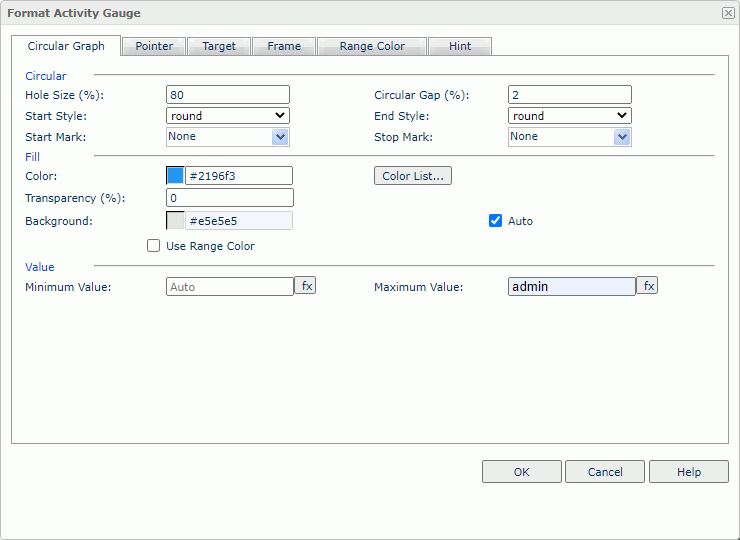
Circular
Specify the size of the circles.
- Hole Size
Specify the relative size of a circle in a percentage of the total circle size. - Circular Gap
Specify the distance between the circles. - Start Style
Select the style for the start graph of the circles. - End Style
Select the style for the end graph of the circles. - Start Mark
Select the mark for the start graph of the circles. - Stop Mark
Select the mark for the stop graph of the circles.
Fill
Specify the fill color of the circles.
- Color
Specify the color of the circles. - Color List
Select to open the Color List dialog box to specify the color of the circles. - Transparency
Specify the transparency for the color of the circles. - Background
Specify the background color of the circles.- Auto
Select to use colors that are lighter than the circles automatically. You cannot specify the Background color when you select Auto.
- Auto
- Use Range Color
Select to use the color you defined for the ranges as the color of the circles. Then, Server disables the Color, Color List, and Transparency properties.
Value
Specify the values you want to display in the chart.
- Minimum Value
Specify the minimum value in the chart. - Maximum Value
Specify the maximum value in the chart.
Pointer Tab Properties
Specify properties of the pointers in the activity gauge.
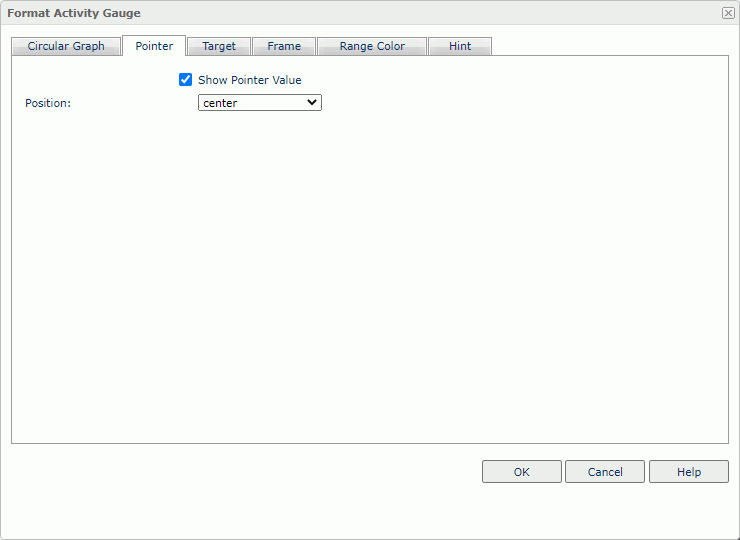
Show Pointer Value
Select to show the pointer values.
- Position
Select the position relationship of the value and the pointers. If you select customized, the X and Y settings on the General tab of the Format Pointer Label dialog box will take effect.
Target Tab Properties
Specify properties of the target in the activity gauge.
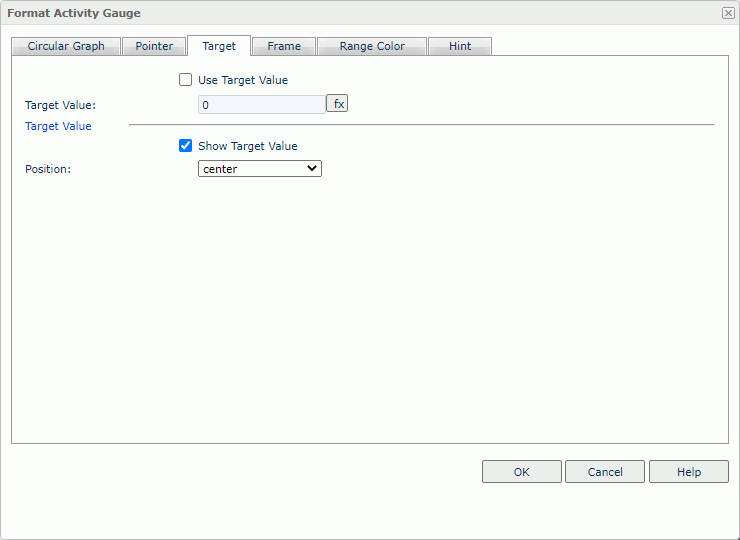
Use Target Value
Select to use the target value for the activity gauge.
- Target Value
Specify the value of the target.
Target Value
Specify the properties of the target value.
- Show Target Value
Select to show the target value on the activity gauge.- Position
Select the position of the target value relative to the circle. If you select customized, the X and Y settings on the General tab of the Format Target Label dialog box will take effect.
- Position
Frame Tab Properties
Specify the frame properties of the activity gauge chart.
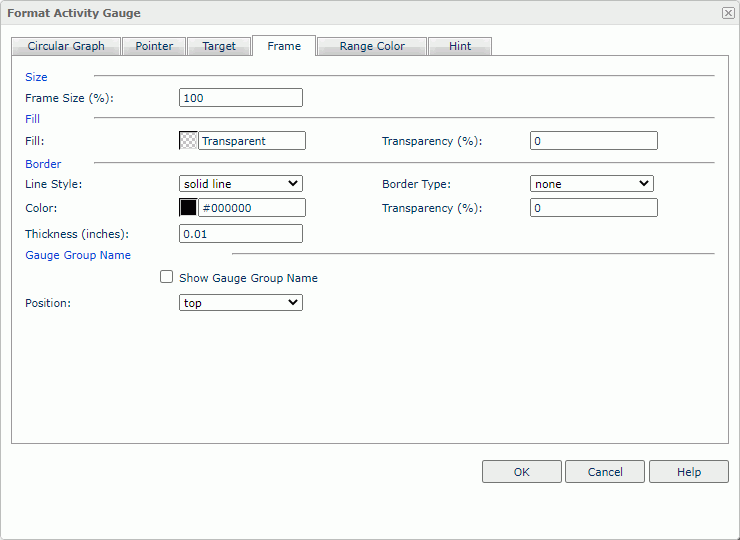
Size
Specify the size properties of the frame.
- Frame Size
Specify the size of the frame.
Fill
Specify the color and transparency of the frame.
- Fill
Specify the color to fill the frame. - Transparency
Specify the transparency of the color to fill the frame.
Border
Specify the properties for the border of the frame.
- Line Style
Select the line style of the border. - Border Type
Select the type of the border. - Color
Specify the color of the border. To change the color, select the color indicator to access the Select Color dialog box, and then specify a new color. You can also type a hexadecimal RGB value to specify a color, for example, #9933ff. - Transparency
Specify the transparency for the color of the border. - Thickness
Specify the thickness of the border, in inches.
Gauge Group Name
Specify the properties for the gauge group name.
- Show Gauge Group Name
Select to show the names for the circles in the activity gauge, which are values of the field on the category axis. If the activity gauge contains no category field, the group name shows Report by default.- Position
Select the position of the names relative to the circles. If you select customized, the X and Y settings on the General tab of the Format Gauge Label dialog box will take effect.
- Position
Range Color Tab Properties
Specify different colors to fill the circles in the activity gauge in different ranges.
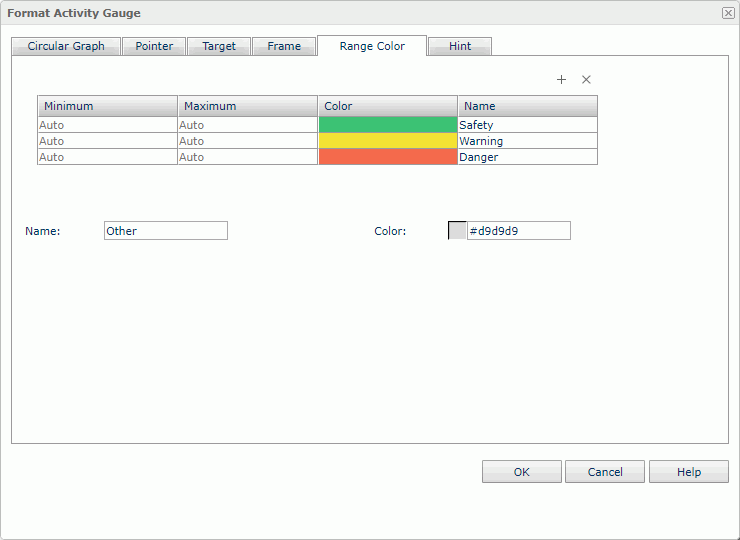
 Add button
Add button
Select to add a new color range.
 Remove button
Remove button
Select to remove the selected color range.
Range table
-
Minimum
Specify the minimum value of a range. -
Maximum
Specify the maximum value of a range. -
Color
Select the color cell to open the Select Color dialog box, and specify a new color. -
Name
Specify the name of a range.
Others
Specify the properties for values that do not fall into any of the ranges you define in the range table.
- Name
Specify the name for the values. - Color
Specify the color for the values. To change the color, select the color indicator to access the Select Color dialog box, and then specify a new color. You can also type a hexadecimal RGB value to specify a color, for example, #9933ff.
Hint Tab Properties
Specify the properties of the data marker hint.
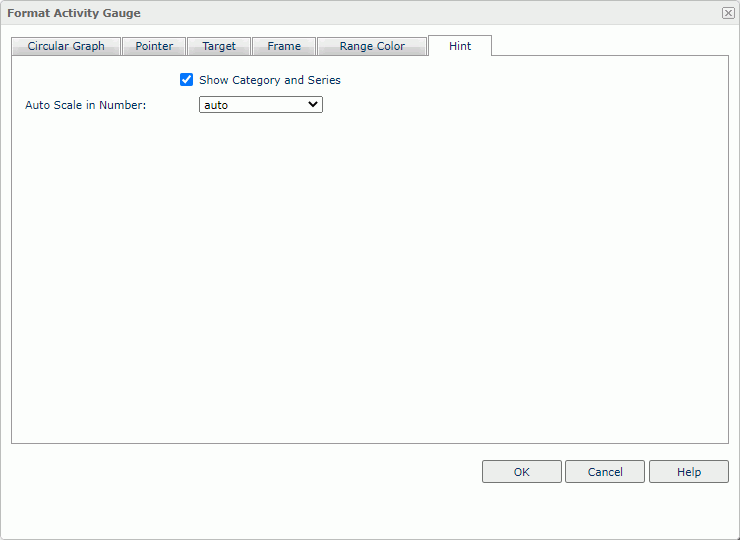
Show Category and Series
Select to include the category and series values in the data marker hint.Auto Scale in Number
Select true if you want to automatically scale the values that are of the Number data type when the values fall into the two ranges:- When 1000 <= value < 10^15, Report uses the following quantity unit symbols of the International System of Units to scale the values: K (10^3), M (10^6), G (10^9), and T (10^12).
- When 0 < value < 0.001 or value >= 10^15, Report uses scientific notation to scale the values.
The default value auto means that the setting follows that of the chart platform.
 Previous Topic
Previous Topic
 Back to top
Back to top